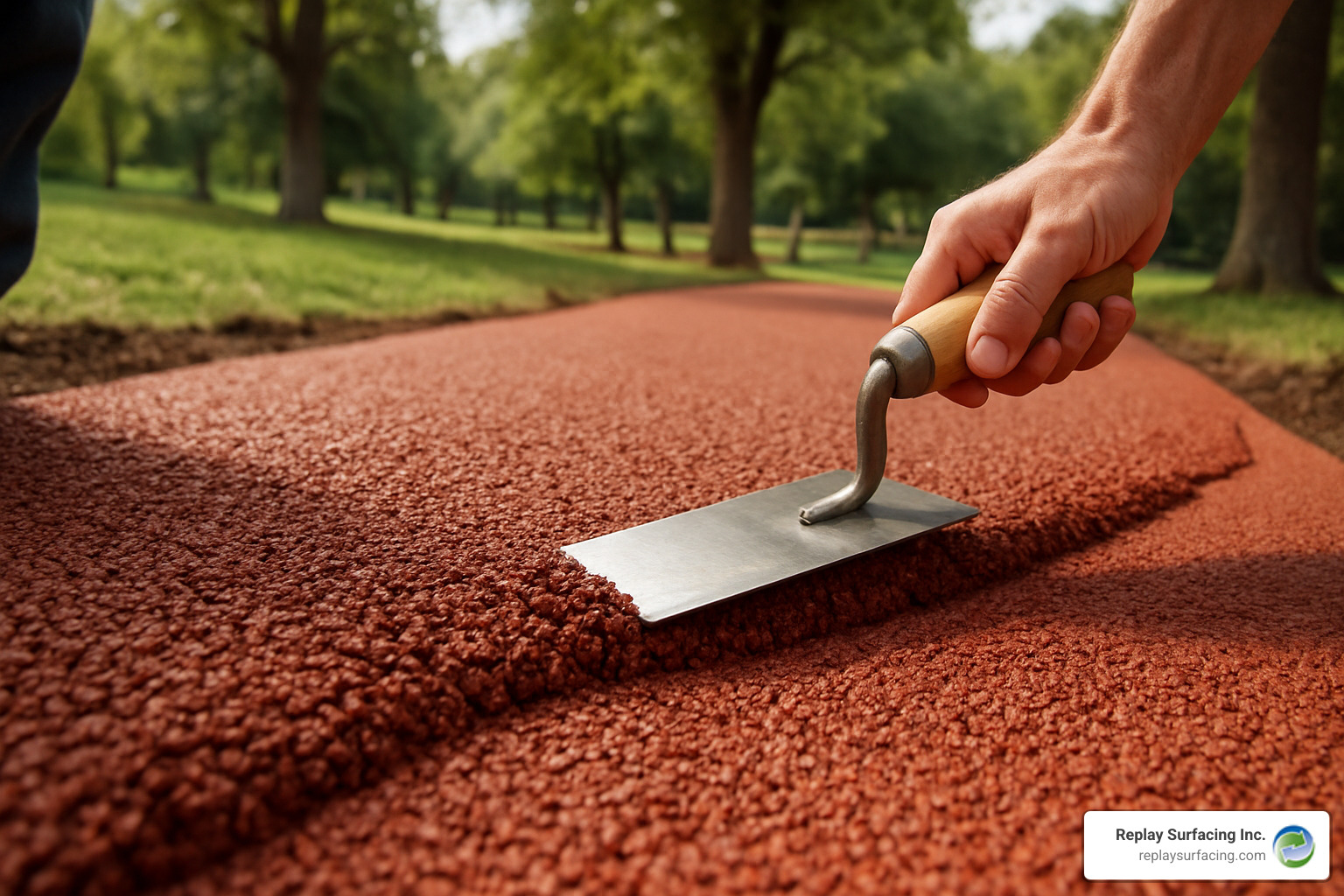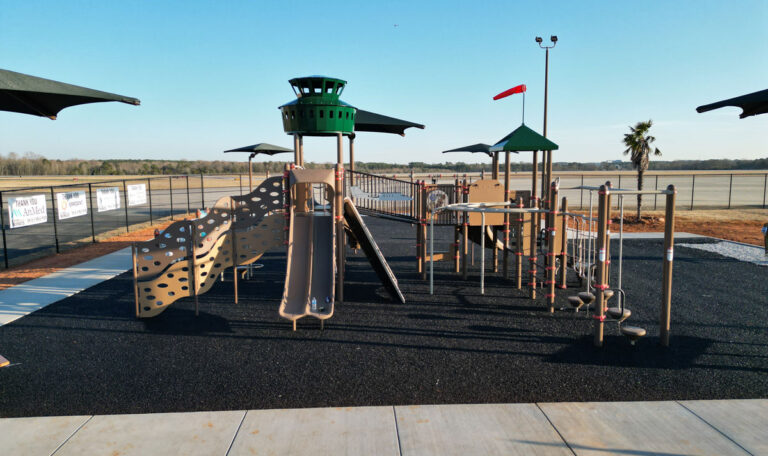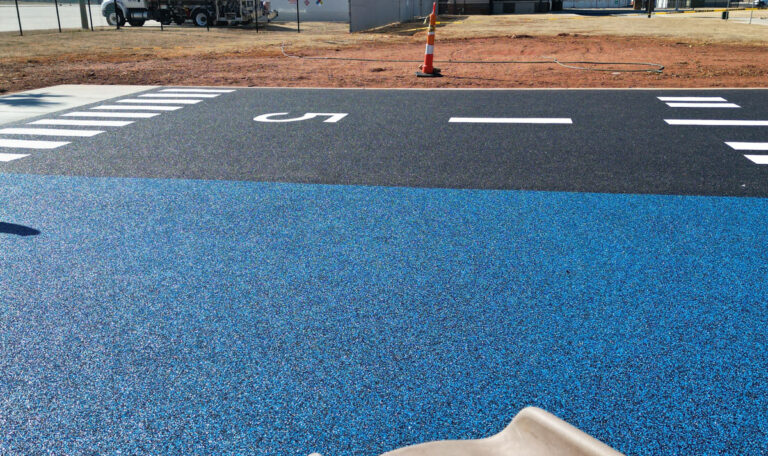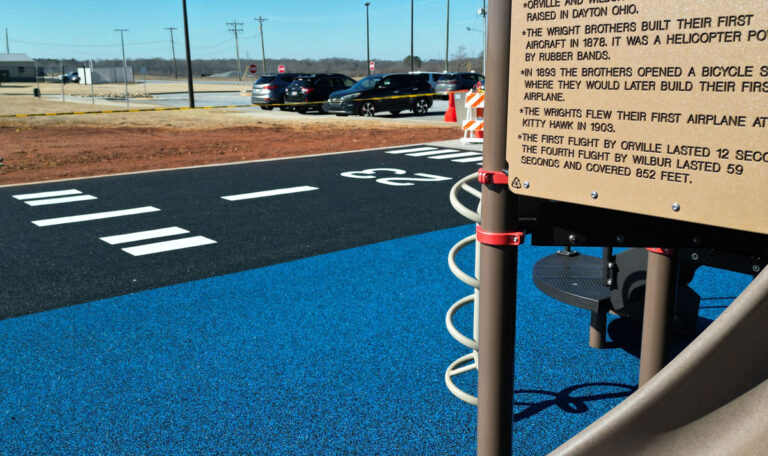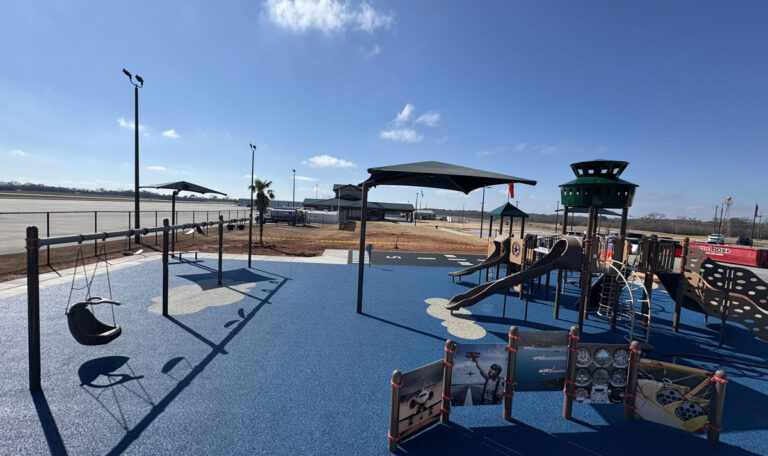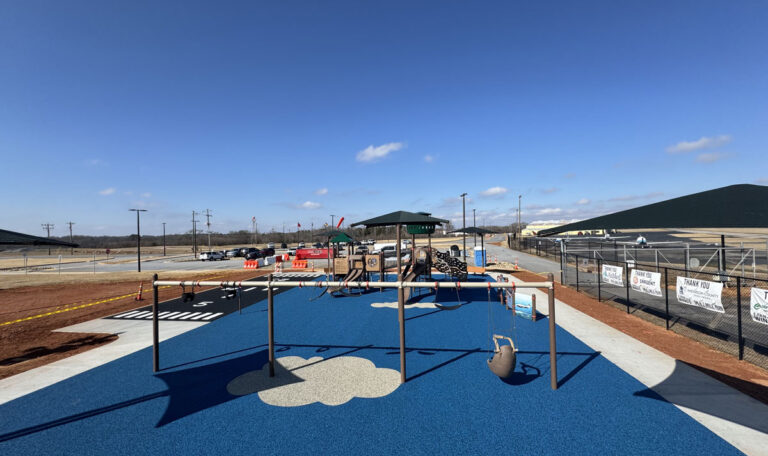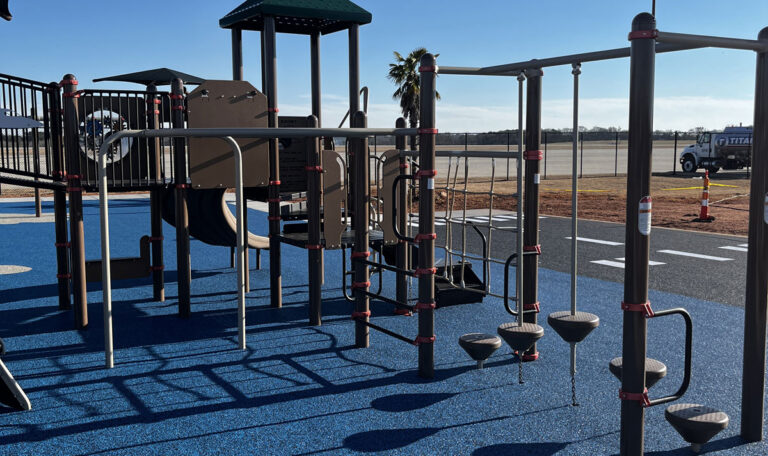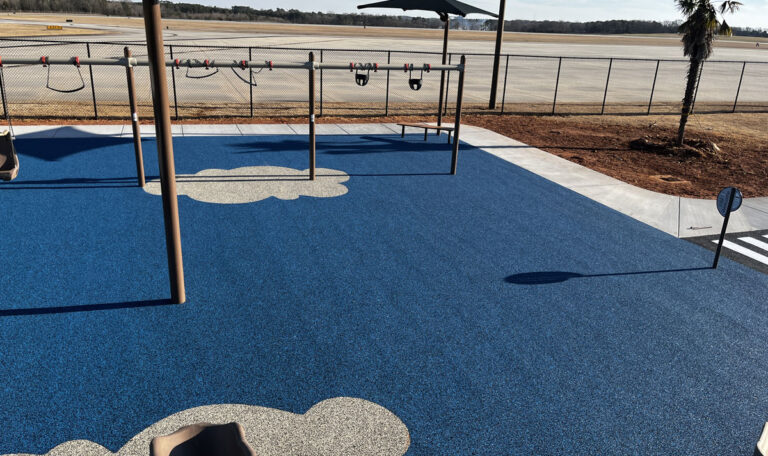Why Bound Rubber Mulch Installation is Easier Than You Think
Bound rubber mulch is a one-layer surfacing system made from recycled tire rubber mixed with a binding agent, then troweled on-site to create a seamless, natural-looking surface. Here’s what you need to know:
Key Installation Facts:
– Installation time: 1 day for most projects
– Mix ratio: 5:1 (rubber to binder by weight)
– Depth needed: 40-50mm general use, up to 6 inches for playground safety
– Base options: Compacted stone, concrete, or asphalt
– Curing time: 24-48 hours before use
– DIY friendly: Yes, with proper tools and preparation
Unlike loose rubber mulch that scatters and requires constant raking, bound rubber mulch stays put. It meets ASTM F1292 safety standards and ADA accessibility requirements while offering the natural wood-chip appearance many facility managers prefer.
The installation process involves mixing shredded rubber with an aromatic binder, then hand-troweling the mixture to create a porous, impact-absorbing surface. A two-person team can typically install about 100 square meters per day.
Temperature matters: Don’t install when temperatures are below 5°C or above 25°C, and avoid rainy conditions during the 24-hour cure period.
I’m Landon Olson, a mechanical engineer with an MBA who specializes in recycling scrap tires into sustainable surfacing solutions at Replay Surfacing. Over the past decade, I’ve helped facilities transform millions of pounds of waste tires into durable bound rubber mulch surfaces that last 10+ years with minimal maintenance.

Basic bound rubber mulch glossary:
– resin bound rubber crumb
– loose fill playground surfacing
– soft fall playground
Bound Rubber Mulch 101—What, Why & Safety Standards
Bound rubber mulch starts with shredded rubber pieces from recycled tires mixed with a single-component MDI polyurethane binder at a 5:1 ratio by weight. When troweled on-site, it creates a seamless, porous surface that looks remarkably like natural wood chips but with superior performance.
Safety standards aren’t just suggestions—they’re requirements. The ASTM F1292 standard for head impact protection requires up to 6 inches of material to protect a child from a 10-foot fall. The surface also meets ADA compliance requirements by creating a firm, stable surface that wheelchairs and mobility equipment can steer easily.
Here’s where bound rubber mulch really shines: it stays put. While traditional mulch scatters across parking lots, the binder creates a single cohesive layer that won’t budge under heavy use or harsh weather. For technical details on critical fall height requirements, check out this Scientific research on critical fall height.
Key Benefits of Bound Rubber Mulch
Impact absorption provides excellent shock absorption, significantly reducing injury risk from falls. The porous structure compresses on impact like a sponge, then springs back to its original shape.
Weed control becomes effortless with a unitary surface. Since there are no gaps for seeds to germinate, bound rubber mulch naturally suppresses weed growth without herbicides.
Insect resistance is another advantage. Rubber doesn’t attract termites, carpenter ants, or other insects that commonly infest organic mulches.
Superior drainage keeps surfaces safe and dry. Water drains quickly through the porous material, preventing puddles and reducing slip hazards. Unlike wood chips that become waterlogged, rubber mulch dries rapidly after rain.
How Bound Rubber Mulch Differs from Other Surfaces
Loose rubber mulch requires constant maintenance to maintain proper depth and distribution. It costs $3-$5 per square foot compared to $8-$16 for the bound version, but ongoing maintenance costs often make bound rubber more economical over its 10+ year lifespan.
Poured-in-place rubber creates a smooth surface but lacks the natural wood-chip appearance and requires specialized installation equipment.
Engineered wood fiber decomposes over time, requiring regular replacement while attracting insects and developing mold in wet conditions.
| Surface Type | Initial Cost | Maintenance | Lifespan | Safety Rating |
|---|---|---|---|---|
| Bound Rubber Mulch | $8-16/sq ft | Very Low | 10+ years | Excellent |
| Loose Rubber Mulch | $3-5/sq ft | High | 10+ years | Good |
| Wood Fiber | $2-4/sq ft | Very High | 2-3 years | Fair |
| Poured Rubber | $10-20/sq ft | Low | 10+ years | Excellent |
Planning & Site Preparation Before Installation
Proper site preparation separates successful installations from weekend frustrations. After helping thousands of property owners transform their spaces, I’ve learned that the prep work is where most DIY projects succeed or fail.
Start with accurate measurements. For playgrounds, measure not just the equipment footprint but the fall zones too. Swings need 6 feet of clearance on each side, and slides require fall zones extending from where kids land.
Depth planning depends on your equipment’s critical fall height. Basic landscaping needs 40-50mm (2 inches) of bound rubber mulch. Playground equipment under 4 feet high requires 3-4 inches, while equipment between 4-8 feet needs 4-6 inches. High equipment reaching 8-10 feet requires a full 6 inches minimum.
Base layer choice affects everything. Type 2 road base (compacted crushed stone) provides excellent drainage and stability—my go-to recommendation. Concrete offers the most stable foundation but requires careful drainage planning. Asphalt provides good stability with natural drainage properties.
Weather timing matters. Don’t install when temperatures drop below 5°C (41°F) or climb above 25°C (77°F). High humidity extends curing times, while blazing sun can cause the surface to cure too fast and crack.
Essential tools include a forced-action or paddle mixer, trowels and floats for finishing, safety glasses, dust masks, work gloves, and measuring tools for consistent depth.
For detailed guidance on material selection, check out our Installing Rubber Mulch resource page.
Meeting ASTM & ADA Requirements in Your Design
Fall zone calculations follow ASTM F1487 guidelines. Equipment under 4 feet high needs 6 feet of clearance in all directions. For taller equipment, calculate 1.5 times the equipment height for your fall zone, with that 6-foot minimum always applying.
ADA accessibility requirements mean creating firm, stable routes for wheelchairs and mobility equipment. Keep accessible routes to a maximum 1:20 slope (5%), avoid level changes greater than 1/4 inch, and create smooth transitions where your surface meets other materials.
Before installation, verify that your fall zones meet ASTM F1487 requirements, your surface depth satisfies ASTM F1292 safety standards, your accessible routes comply with ADA guidelines, and your drainage prevents standing water.
Step-by-Step Bound Rubber Mulch Installation Guide
Installing bound rubber mulch is straightforward when you follow the process carefully and respect the timing. The golden ratio is 5:1 rubber to binder by weight. For every 20 kg of rubber mulch, you’ll need exactly 4 kg of aromatic binder.
Once mixed, you have about 30-45 minutes of working time before the mixture becomes too stiff to trowel. Hot weather shortens this to 20 minutes, while cooler temperatures give you closer to an hour.
Start small with your first batch covering 2-3 square meters, then scale up. Most DIY installers can complete about 100 square meters in a full day with a helper.

Base Construction & Primer Application
Compacted road base is our top choice. Excavate to your required depth—typically 4-6 inches below final grade. Install Type 2 road base in layers, compacting each 2-inch lift thoroughly.
Geotextile fabric goes over your prepared base to prevent mixing with underlying soils while allowing drainage. Never use plastic sheeting—it creates drainage problems.
Primer application provides insurance for long-term adhesion, especially over concrete or asphalt. Apply according to manufacturer specifications and wait for it to become tacky.
Mixing Rubber & Binder Like a Pro
Coverage calculations: At 50mm depth, plan on 20 kg of mulch and 4 kg of resin per square meter. At 40mm depth, you’ll need 16 kg of mulch and 3.2 kg of resin per square meter.
Weather limits: Avoid installation when temperatures drop below 5°C or climb above 25°C. Don’t work when rain threatens within 24 hours or humidity exceeds 85%.
Batch size: Mix only what you can install in 30-45 minutes. A typical batch runs 40-50 kg of total material, covering roughly 2-2.5 square meters at 50mm depth.
Troweling, Texturing & Creating Seamless Edges
Troweling technique requires a light touch. Use gentle, sweeping motions to spread material evenly. Heavy-handed troweling compacts the surface excessively and destroys the natural texture.
Thickness gauges ensure safety standards. Cut a wooden block to your target thickness and use it as a screed guide. Consistent depth protects kids from injuries.
Seamless edges require timing. Slightly overlap each section and blend materials while both remain workable. Around trees or equipment, create smooth transitions that won’t collect debris.
For technical guidance on resin binding, see our Resin Bound Rubber Mulch resource.
Curing & First-Week Care
Ideal curing temperatures range between 10-20°C (50-68°F). The surface continues gaining strength for up to seven days.
Traffic restrictions: Keep everyone off the surface for 24 hours. Light foot traffic might be acceptable after 24-48 hours, but avoid heavy use for at least 72 hours.
Weather protection becomes critical if rain threatens during the first 24 hours. Cover with plastic sheeting, but remove it as soon as possible to prevent condensation.
Maintenance, Safety Audits & Climate Performance
Bound rubber mulch maintenance is refreshingly simple. While you’ll spend weekends raking traditional materials, bound surfaces take care of themselves with minimal attention.
Monthly visual inspections are your best maintenance tool. Walk the surface looking for soft spots indicating base settling, surface cracks from temperature changes, or thin areas from heavy use. Most issues are easy to spot and fix when caught early.
A monthly session with a leaf blower or stiff brush keeps organic matter from building up and affecting drainage.
UV fade is normal for outdoor surfaces. The polyurethane coating helps resist fading better than uncoated materials, but some color change after years of sun exposure is purely cosmetic—safety properties remain unaffected.
Heat management becomes important in sunny climates. Lighter colors reflect more heat, and strategic shade structures make a huge difference in user comfort.
Climate resilience is a key advantage. The surface doesn’t freeze solid in winter, springs back after heavy rain, and handles freeze-thaw cycles that destroy other materials.

When & How to Patch Bound Rubber Mulch
Small divots and depressions are the most common repairs. Clean the area thoroughly, roughen the edges slightly with sandpaper for better adhesion, then apply a small batch of rubber and binder mixture. Trowel smooth and let cure.
High-wear zones under swings or at slide exits need special attention. Consider upgrading to EPDM wear pads during maintenance, or apply a slightly thicker patch to handle extra abuse.
Binder compatibility is crucial. Always use the same type of binder system as your original installation. Mixing different binder chemistries won’t hold up over time.
Cost, Color Options & Environmental Impact
Bound rubber mulch installation typically runs $8 to $16 per square foot for projects over 1,000 square feet. Depth requirements matter most—6 inches for high playground equipment costs more than 2-inch landscaping applications. DIY enthusiasts can save 40-60% on total project costs by providing their own labor.

Color options include up to seven colors, from natural rubber tones that mimic wood mulch to vibrant playground colors. Brown and black combinations create authentic wood chip looks, while green works beautifully for landscaping. Red, blue, and yellow options create colorful playground designs. You can create custom blends by mixing colors during installation.
The environmental impact makes us proud: every square foot diverts approximately 5-7 tires from landfills. When your surface eventually reaches end-of-life after 10+ years, it can be recycled again—a true circular economy.
We use low VOC binders to minimize emissions, keeping air clean for kids and adults. Find detailed safety information on our Non-Toxic Rubber Mulch page.
Design Ideas: Trails, Animal Facilities & Beyond
Landscaping borders eliminate loose mulch that blows away, providing attractive, permanent borders around trees and walkways with excellent weed suppression.
Dog parks benefit from joint-friendly cushioning that stays hygienic and comfortable. Equestrian facilities appreciate the excellent traction and comfort for horses’ joints.
Trail applications create accessible paths with cushioning for walkers and joggers while meeting ADA requirements without looking institutional.

Frequently Asked Questions about Bound Rubber Mulch
After installing bound rubber mulch surfaces across thousands of facilities, here are the most common questions with honest answers based on real-world experience.
How thick should bound rubber mulch be under playground equipment?
Thickness depends on fall height. ASTM F1292 standards require 6 inches of material to protect against a 10-foot fall. A 4-foot climber needs 3-4 inches minimum, while an 8-foot slide requires 5-6 inches. I recommend adding an extra half-inch for settling and wear.
This thickness applies to the entire fall zone around equipment, not just directly underneath.
Can homeowners install bound rubber mulch themselves?
Absolutely! The process is straightforward—mix, pour, trowel, and cure. You’ll need access to a forced-action mixer and must work efficiently during that 30-45 minute window after mixing.
Physical fitness matters. Mixing and troweling is hard work, especially for larger areas. Consider recruiting help or tackling the project in smaller sections.
The biggest mistake is underestimating proper base preparation. Skip this step and you’ll have problems regardless of perfect surface installation.
Does bound rubber mulch get too hot in summer?
Bound rubber mulch can get warm in direct sunlight—about as hot as asphalt or metal playground equipment. Lighter colors make a huge difference, staying 15-20 degrees cooler than dark surfaces.
Shade structures over high-use areas dramatically reduce surface temperatures. Surface temperatures are typically comfortable in early morning and evening hours.
Footwear is common sense—children should wear appropriate shoes during peak heat periods, just like on any outdoor surface.
For research on playground surface temperatures, see this Scientific research on surface temperatures.
Heat can be managed through smart design and common-sense usage. The safety benefits and low maintenance far outweigh occasional heat management needs.
Conclusion
Bound rubber mulch transforms discarded tires into surfaces that protect children while they play. This guide covered every installation step, from planning to final curing. The process is straightforward: mix rubber with binder at a 5:1 ratio, trowel smooth, and cure. This creates a surface protecting children for over a decade with minimal maintenance.
The environmental impact is compelling—every square foot keeps 5-7 tires out of landfills, turning waste into safety solutions. The numbers speak for themselves: 10+ years service life, minimal maintenance, and compliance with all safety standards.
Whether you’re a facility manager upgrading playgrounds or a homeowner creating backyard play areas, bound rubber mulch delivers performance matching its environmental benefits. The installation remains accessible to DIY enthusiasts with proper tools and preparation.
At Replay Surfacing Inc., we’ve perfected changing waste tires into high-performance surfaces. Every installation represents our commitment to safer play environments while addressing environmental challenges—work that protects children’s safety and our planet’s future.
Ready to get started? Whether planning small residential projects or large commercial installations, we’re here to help. From material supply to complete installation services, we’ll guide you through the process and ensure your bound rubber mulch surface meets all safety standards while exceeding expectations.
Contact us for a free consultation and quote. Let’s create a surface that’s safe for children, kind to the environment, and built to last.
For comprehensive information about all our playground surfacing options, explore our playground surfacing resource center.

